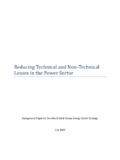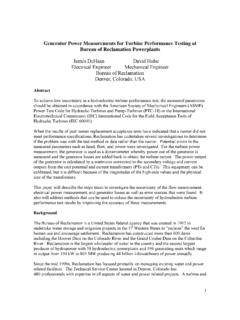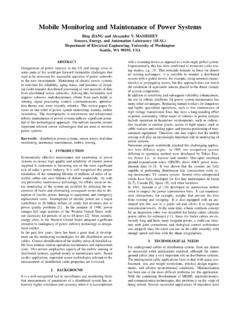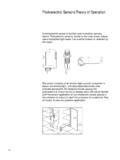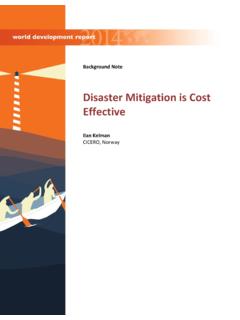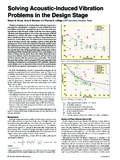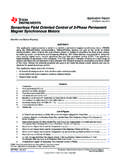Transcription of Options for Removing Accumulated Fluid and …
1 Lessons Learned from Natural Gas STAR Partners Options for Removing Accumulated Fluid and improving Flow in Gas Wells Executive Summary When first completed, many natural gas wells have sufficient reservoir pressure to flow formation fluids (water and liquid hydrocarbon) to the surface along withthe produced gas. As gas production continues, the reservoir pressure declines, and as pressure declines, the velocity of the Fluid in the well tubing decreases. Eventually, the gas velocity up the production tubing is no longer sufficient to lift liquid droplets to the surface.
2 Liquids accumulate in the tubing, creating additional pressure drop, slowing gas velocity, and raising pressurein the reservoir surrounding the well perforations and inside the casing. As the bottom well pressure approachesreservoir shut-in pressure, gas flow stops and all liquidsaccumulate at the bottom of the tubing. A common approach to temporarily restore flow is to vent the well tothe atmosphere (well blowdown ), which produces substantial methane emissions. The Inventory of Greenhouse Gas Emissions and Sinks 1990 2008 estimates billion cubic feet (Bcf) of annual methane emissions from venting of low pressure gas wells.
3 At different stages in the life of a gas well, various alternatives to repeated well venting can be deployed tomove Accumulated liquids to the surface. These Options include: Foaming agents or surfactants Velocity tubing Plunger lift, operated manually or with smart wellautomation Downhole pumps, which include reciprocating (beam)pumps and rotating (progressive cavity) pumps. Natural Gas STAR Partners report significant methane emission reductions and economic benefits from implementing one or more lift Options to remove Accumulated liquids in gas wells. Not only are ventedmethane emissions reduced or eliminated, but these lift techniques can provide the additional benefit of increasedgas production.
4 Method for reducing Natural Gas Losses Volume of Natural Gas Savings and Incremental Production1 (Mcf/well/year) Value of Natural Gas Savings and Additional Production (Mcf/well/year) Implementation Cost1 (2010 $/Well) Project Payback (years) $3 per Mcf $5 per Mcf $7 per Mcf $3 per Mcf $5 per Mcf $7 per Mcf Use Foaming Agents 500 9,360 $1,500 -$28,080 $2,500 -$46,800 $3,500 -$65,520 $500 - $9,880 0 to 7 0 to 4 0 to 3 Install Velocity Tubing 9,285 27,610 $27,855 -$82,830 $46,425 -$138,050 $64,995 -$193,270 $7,000 - $64,000 0 to 3 0 to 2 0 to 1 Smart Well Automated Controls for Plunger Lift2 800 1,4632 $2,400 -$4,389 $4,000 -$7,315 $5,600 -$10,241 $5,700 - $18,000 1 to 8 1 to 5 1 to 4 Install Rod Pumps and Pumping Units2 973 2,0402 $2,919 -$6,120 $4,865 -$10,200 $6,811 -$14,280 $41,000 - $62,000 6 to 22 4 to 13 1 Based on results reported by Natural Gas STAR Partners 2 Does not include incremental gas production.
5 Includes only potential gas savings from avoided well venting. 3 to 10 Economic and Environmental Benefits 1 Options for Removing Accumulated Fluid and improving Flow in Gas Wells (Cont d) By avoiding or reducing well blowdowns, Partners report annual methane emissions savings that range from 500 thousand cubic feet (Mcf) per well to more than 27,000 Mcf/well. The benefit of increased gas production will varyconsiderably among individual wells and reservoirs, butcan be substantial. For example, Partners report thatincreased gas production following plunger lift installationyielded as much as 18,250 Mcf per well.
6 Technology Background Most gas wells will have liquid loading occur at some point during the productive life of the well. When this occurs, a common course of action to improve gas flow includes: Shutting in the well to allow bottom hole pressure to increase, Swabbing the well to remove Accumulated fluids, Venting the well to the atmosphere (well blowdown), Installing an artificial lift system. No-Emissions Solutions for Liquid Loading in Gas Wells: Foaming Agents/ Surfactants Low cost/ low volume lift method Applied early in production decline, when the bottom hole pressure still generates sufficient velocity to lift liquid droplets Velocity Tubing Low maintenance, effective for low volumes lifted Somewhat expensive to acquire and install Often deployed in combination with foaming agents Plunger Lift Long lasting Less expense to install and operate than a pumping unit Often, plunger lift cannot produce a well to its economic limit (abandonment).
7 Challenging to operate effectively; requires more time and expertise to manage. Rod Pumping Units Can be deployed in applications to remove greater liq-uid volumes than plunger lift. Swabbing and blowing down a well to temporarily restore production can vent significant methane emissions,from 80 to 1600 Mcf/year per well. The process must be repeated as fluids reaccumulate, resulting in additional methane emissions. Operators may wait until well blowdown becomes increasingly ineffective before implementing some type of artificial lift. At this point, the cumulative methane emissions from a well could be substantial. Natural Gas STAR Partners have found that applyingartificial lift Options early in the life of a well offers significant emissions savings and economic benefits.
8 Each method for lifting liquid in a well has advantages and disadvantages for prolonging the economic life of a gas savings and methane emission reductions that result from reducing or eliminating well venting will vary for each well depending on flow line operating pressure,reservoir pressure, liquid volume, specific gravity and thenumber of blowdowns eliminated. Fluid Removal Options for Gas Wells Foaming Agents The use of foam produced by surfactants can be effective for gas wells that accumulate liquid at low rates (Exhibit1). Foam reduces the density and surface tension of the Fluid column, which reduces the critical gas velocity needed to lift fluids to surface and aids liquid removal from the well.
9 Compared to other artificial lift methods, foaming agents are one of the least costly applications for unloading gas wells. Foaming agents work best if the Fluid in thewell is at least 50 percent water. Surfactants are not Exhibit 1: Liquid Foaming Agent Source: S. Bumgardner, Advanced Resources International, inc. 2 Options for Removing Accumulated Fluid and improving Flow in Gas Wells (Cont d) effective for natural gas liquids or liquid hydrocarbons. Surfactants are delivered to the well as soap sticks or as a liquid injected directly into the casing-tubing annulus or down a capillary tubing string. For shallow wells, the surfactant delivery can be as simple as the operator periodically pouring surfactant down the annulus of the well through an open valve.
10 For deep wells, a surfactant injection system requires the installation of surface equipment, as well as regular monitoring. The surface equipment includes a surfactant or soap reservoir, an injection pump, a motor valve with a timer (depending on the installation design), and a power source for the pump(Exhibit 2). No equipment is required in the well, although foaming agents and velocity tubing may be more effective when used in combination. Exhibit 2: Soap Stick Launcher with Automatic Controller Launch Button Access Supply Gas Regulator Supply Gauge Drip Pot Junction Box Vent Valve Pressure Transducer Bypass, Equalizer Actuated Valve Valve Controller Gas Flow Source: S.










